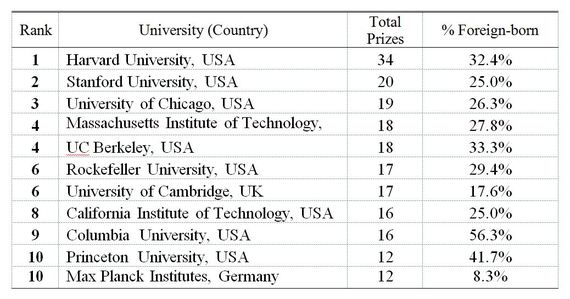It's that time of year again when the Nobel Prizes are awarded -- something of a yearly ritual that can be likened to the falling of the leaves or the changing of seasons. Humans see fit to pause, on occasion, to honor those among us who have excelled, or who have strengthened the human enterprise. Awarded since 1901, the Nobel Prize was established by Alfred Nobel -- Swedish chemist, inventor, engineer, entrepreneur and pacifist -- who left millions to fund the prizes and to honor "those who, during the preceding year, shall have conferred the greatest benefit on mankind."
And as rituals go, we can see patterns in the prize, its recipients and the institutions affiliated with these recipients. Many more men than women receive the prize, more Americans (over 1/3) than any other nation, and from an institutional view, more recipients from Harvard than any other university. By far, Harvard University, as a single institution, has the greatest share of recipients with 33; the nearest "contenders" are Stanford with 19 and MIT with 18. However, though these top "institutional recipients" are in the United States, not all of the individual honorees representing these institutions are native-born to the U.S.
In the table below, researchers from George Mason University's Institute for Immigration Research have ranked the "institutional recipients" of Nobel Prizes and the corresponding number of individual honorees who are foreign-born. An "institutional recipient" is a university or research center of which a Nobel honoree was employed or serving as faculty at the time of the award, and some honorees have more than one institutional affiliation. This table includes all Nobel Prize recipients from 1901 to 2013. As can be seen, the contributions of the foreign-born to the "Nobel honors" received by an institution should not be overlooked, particularly as the foreign-born population in the U.S. currently stands at an estimated 13 percent of the total population. Yet Harvard owes over 30 percent of its Nobel honors to its foreign-born scholars, UC-Berkeley over 35 percent, and Columbia and Princeton over 53 percent and 41 percent respectively. Note that among these prize-winning educational institutions only two are not in the U.S. -- the University of Cambridge in the U.K. and the Max Planck Institutes in Germany. It is often said that the top universities in the world are in the United States. However, this statement, on the surface, leads one to believe that these top institutions "did it all on their own" and are populated with "homegrown" U.S. scholars, but clearly this is not the case.
Top Ten Universities by Nobel Prizes and Percentage of Foreign-born Recipients
Digging deeper into these institutions, and into their "top academic departments," departments that one could argue represent an important pool for future Nobel Laureates, we find the foreign-born quite present and active. Presently, in 2013, of the full-time tenured and tenure-track faculty in Harvard's Economics Department, over 40 percent are foreign-born and their Physics Department is over 44 percent. Stanford's Economics Department stands at over 40 percent foreign-born, MIT Economics at 50 percent, and Princeton Economics over 60 percent. This is just a small sample of the impact of the foreign-born among our leading scholars.
Additionally, consider some of the specific contributions of the foreign-born while affiliated with these institutions: a 1953 Nobel Prize to German-born Fritz Lipmann for discoveries in cell physiology and metabolism while affiliated with Harvard, a 1979 Nobel Prize to Saint Lucian Sir Arthur Lewis for his pioneering research in developmental economics while at Princeton and in 1990, a Nobel Prize to Canadian particle physicist Richard E. Taylor while at Stanford. And just this year, 2013, German-born Thomas C. Südhof, in cell physiology, at Stanford, and three Prizes in chemistry: Austrian Martin Karplus at Harvard, South African Michael Levitt at Stanford and Israeli Arieh Warshel at the University of Southern California. The pattern of foreign-born contribution, obviously, continues...
This year, as the leaves fall, the winds cool, and the world prepares for the rituals of the season, we in America should recognize the role that immigrants have played in establishing the nation's scholarly preeminence. As the Nobel Prize honors prestigious institutions like Harvard, Princeton and MIT, should we not be digging to the roots of such honors -- some of the best and the brightest who have immigrated to the U.S. from all over the world? We have struggled, as a country, to look in the mirror, to acknowledge and admit the immigrant that is ourselves. We honor ourselves, by honoring our immigrants.
Jean Boucher and James Witte
George Mason University, Institute for Immigration Research
